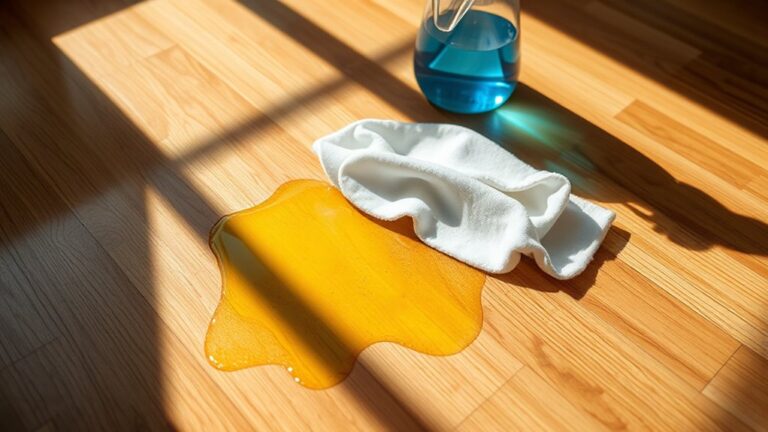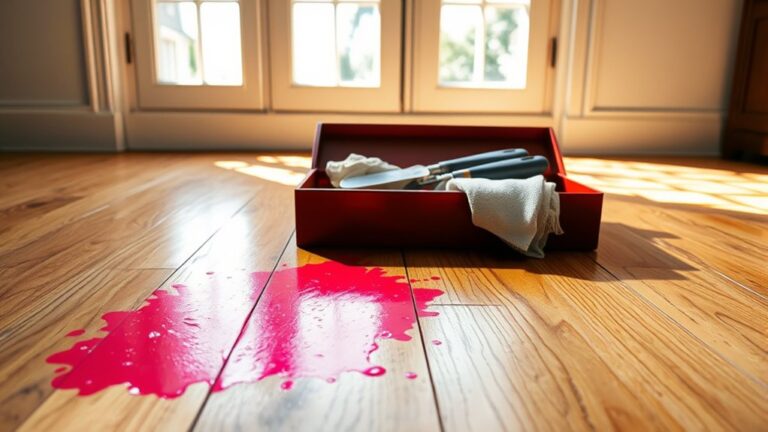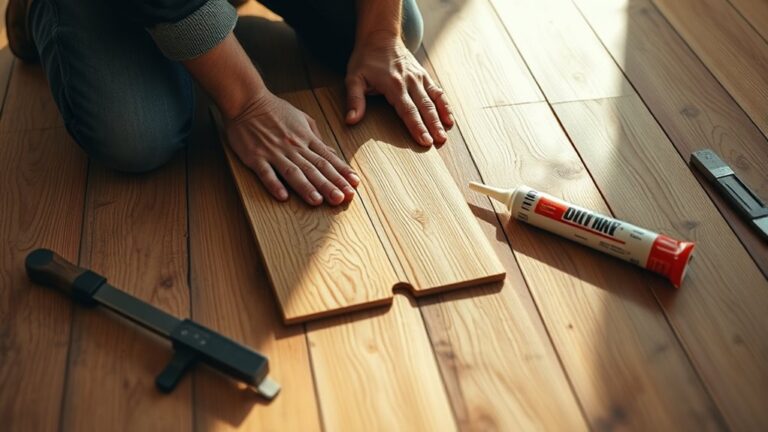Dark spots on your hardwood floors often result from moisture damage, pet urine, mold, or reactions between metal objects and wood tannins. Exposure to harsh cleaning chemicals and prolonged sunlight or foot traffic can also degrade finishes, causing discoloration. Moisture beneath the surface triggers chemical changes, while abrasion allows dirt to penetrate deeper. If you want to understand how these factors interact and discover ways to prevent and treat dark spots, keep exploring these essential details.
Water Damage and Moisture Exposure

Although hardwood floors are durable, they’re highly susceptible to dark spots caused by water damage and prolonged moisture exposure. When moisture accumulation occurs beneath the surface, it initiates chemical reactions within the wood fibers, leading to discoloration. Water exposure disrupts the wood’s cellular structure, encouraging mold and mildew growth, which further darkens the affected areas. If you want to maintain the natural appearance and freedom to enjoy your space without unsightly stains, controlling moisture levels is essential. Immediate cleanup of spills and proper ventilation prevent prolonged dampness. Additionally, installing moisture barriers or using dehumidifiers can considerably reduce water infiltration. Understanding these mechanisms empowers you to protect your hardwood floors effectively and avoid irreversible dark spots caused by water damage and moisture accumulation.
Pet Urine Stains
When pet urine contacts hardwood, its chemicals react with the wood’s tannins, causing dark stains that penetrate deeply. To prevent damage, you should clean accidents promptly and use sealants designed to resist urine absorption. If stains occur, targeted treatments like enzymatic cleaners and light sanding can effectively reduce or remove discoloration.
Chemical Reaction With Wood
Because pet urine contains ammonia and uric acid, it can trigger a chemical reaction with the tannins in hardwood, resulting in dark stains that penetrate deeply into the wood fibers. This tannin reaction causes discoloration by oxidizing the natural compounds within the wood’s structure. When you encounter these stains, it’s not just surface-level damage; the urine’s chemical components initiate wood oxidation, altering the wood’s cellular makeup. This process darkens the affected area, often leaving a permanent mark if untreated. Understanding this reaction is essential because typical cleaning methods may not remove these deep stains. To address the issue effectively, you’ll need to take into account treatments that target the chemical changes within the wood, rather than just surface cleaning, preserving both appearance and integrity.
Preventing Urine Damage
Understanding the chemical reactions that cause pet urine stains on hardwood floors highlights why prevention is your best strategy. Urine absorption into wood fibers initiates a chemical process that results in dark discoloration, so minimizing exposure is key. To effectively prevent stains, promptly clean any urine by blotting with a clean, absorbent cloth to reduce penetration. Applying a high-quality sealant creates a protective barrier, limiting urine absorption and facilitating stain prevention. Additionally, using specialized pet deterrents and training your pet can reduce incidents. Ensuring adequate ventilation and humidity control also slows urine-induced chemical reactions within the wood. By combining immediate cleanup with protective coatings and behavioral measures, you maintain your hardwood’s appearance and preserve its structural integrity, granting you freedom from persistent, unsightly dark spots caused by pet urine.
Effective Stain Removal
Although prevention is ideal, pet urine stains can still occur, and addressing them promptly is essential to avoid permanent damage. Urine penetrates hardwood, leading to distinct stain types, often dark discolorations from tannins and minerals. Effective stain removal requires selecting appropriate removal techniques based on the stain’s depth. For superficial stains, apply enzymatic cleaners designed to break down urine compounds without harming the finish. Deep-set stains may necessitate sanding the affected area followed by refinishing to restore uniformity. Avoid harsh chemicals that can exacerbate discoloration or damage the wood fibers. Consistently blotting moisture immediately after accidents limits stain severity. By understanding these stain types and removal techniques, you maintain your hardwood’s appearance and extend its life, preserving your freedom to enjoy a clean, attractive living space.
Mold and Mildew Growth
When moisture accumulates on hardwood floors, mold and mildew can develop, causing dark spots that penetrate the wood’s surface. These fungi thrive in damp conditions, breaking down organic material and leading to discoloration. To combat this, mold prevention is essential—ensure proper ventilation and promptly address spills or leaks to maintain a dry environment. If dark spots appear, implement mildew treatment using specialized cleaners designed to eliminate fungal growth without damaging the wood. Regular inspection and maintaining consistent humidity levels below 60% will also deter mold formation. By understanding these factors, you can protect your hardwood floors from persistent dark spots caused by mold and mildew, preserving both their appearance and structural integrity over time.
Reaction to Iron or Metal Objects
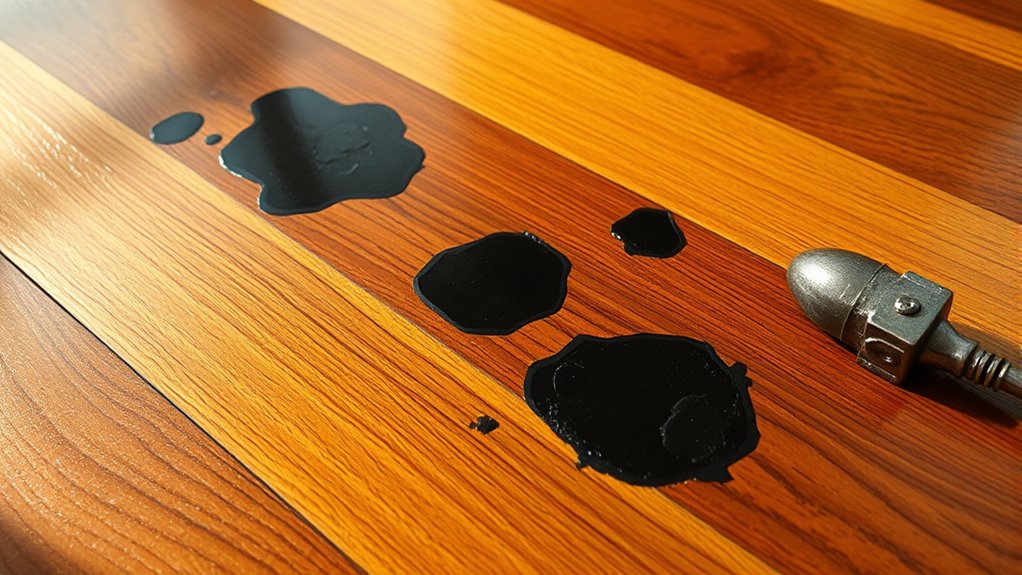
If iron or metal objects remain in contact with hardwood floors, they can cause dark stains through a chemical reaction with the tannins in the wood. This interaction results from metal corrosion, where iron ions oxidize and react with the wood’s natural compounds. The oxidation effects produce iron tannate complexes, which manifest as persistent dark spots. These stains are not surface-level; they penetrate the wood fibers, making removal challenging without refinishing. To prevent this, avoid leaving metal objects like nails, screws, or furniture legs in direct contact with your floor for extended periods. Using protective pads or coatings can minimize oxidation exposure. Understanding this reaction helps you maintain your hardwood’s appearance while preserving the freedom to use metal furnishings without damaging your floor.
Effects of Harsh Cleaning Chemicals
Because hardwood floors are sensitive to chemical exposure, using harsh cleaning agents can cause lasting damage to their finish and structure. When you apply aggressive cleaning solutions containing ammonia, bleach, or acidic compounds, they can penetrate the protective coating, leading to discoloration and dark spots. These chemicals may also break down the wood’s natural oils, resulting in surface damage that weakens the fibers and reduces durability. To maintain your floor’s integrity, you should opt for pH-neutral, wood-specific cleaning solutions designed to clean effectively without compromising the finish. Avoid prolonged exposure to any liquid, as it can exacerbate chemical reactions beneath the surface. By selecting appropriate products and methods, you preserve both the appearance and longevity of your hardwood 床材, ensuring it remains free from dark spots caused by chemical damage.
Wear and Tear From Sunlight and Foot Traffic
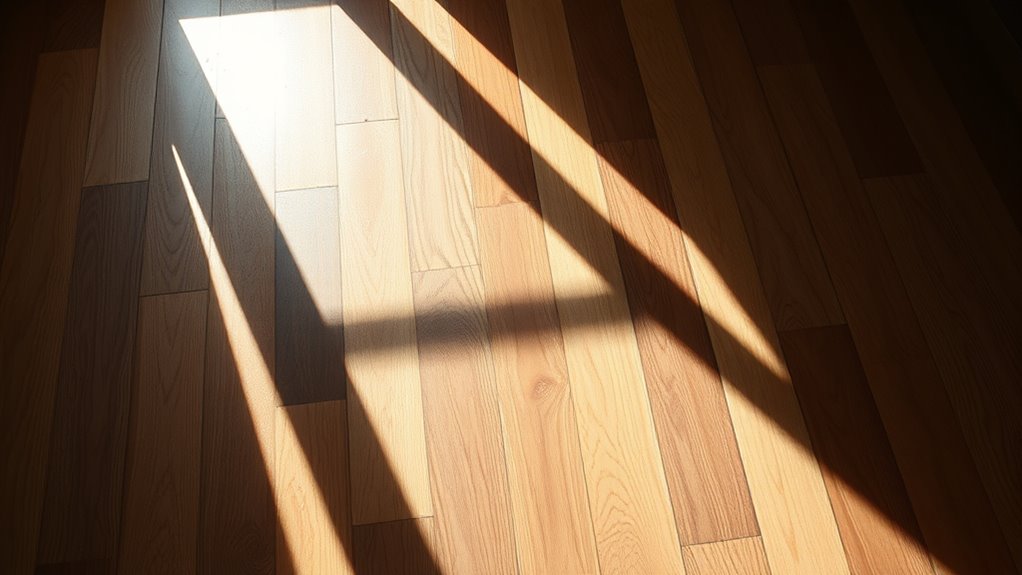
You’ll notice that prolonged exposure to UV light can cause discoloration and darkening of hardwood floors, especially in sunlit areas. Additionally, high-traffic zones experience accelerated wear, leading to surface damage and uneven coloration. Understanding these factors is key to managing and preventing dark spots on your flooring.
UV Damage Effects
While hardwood floors are prized for their durability, prolonged exposure to ultraviolet (UV) rays combined with regular foot traffic accelerates wear and tear, leading to the formation of dark spots and discoloration. UV radiation degrades the wood’s lignin, causing chemical changes that darken its surface unevenly. Without adequate UV protection, sunlight exposure breaks down the floor’s finish, making it more susceptible to moisture infiltration and staining, which manifests as dark spots. Additionally, the interplay of UV damage and abrasion from foot traffic exacerbates surface deterioration. To maintain your floor’s integrity and appearance, implementing UV-blocking window treatments and applying finishes with UV inhibitors is essential. This approach minimizes discoloration caused by sunlight exposure while preserving the wood’s natural beauty and extends its lifespan despite everyday wear.
High-Traffic Area Impact
Several factors converge in high-traffic areas to accelerate the formation of dark spots on hardwood floors, with sunlight exposure and consistent foot traffic being primary contributors. You’ll notice that high traffic patterns cause surface abrasion, allowing dirt and oils to penetrate the wood, leading to discoloration. Additionally, UV rays amplify this effect by breaking down finish layers. Effective flooring maintenance minimizes these impacts by regular cleaning and refinishing.
| 要素 | Effect on Flooring | Maintenance Tip |
|---|---|---|
| Foot Traffic | Abrasion and dirt buildup | Use rugs; clean regularly |
| Sunlight Exposure | UV degradation of finish | Apply UV-resistant coatings |
| Dirt & Oils | Deep staining | Immediate spot cleaning |


